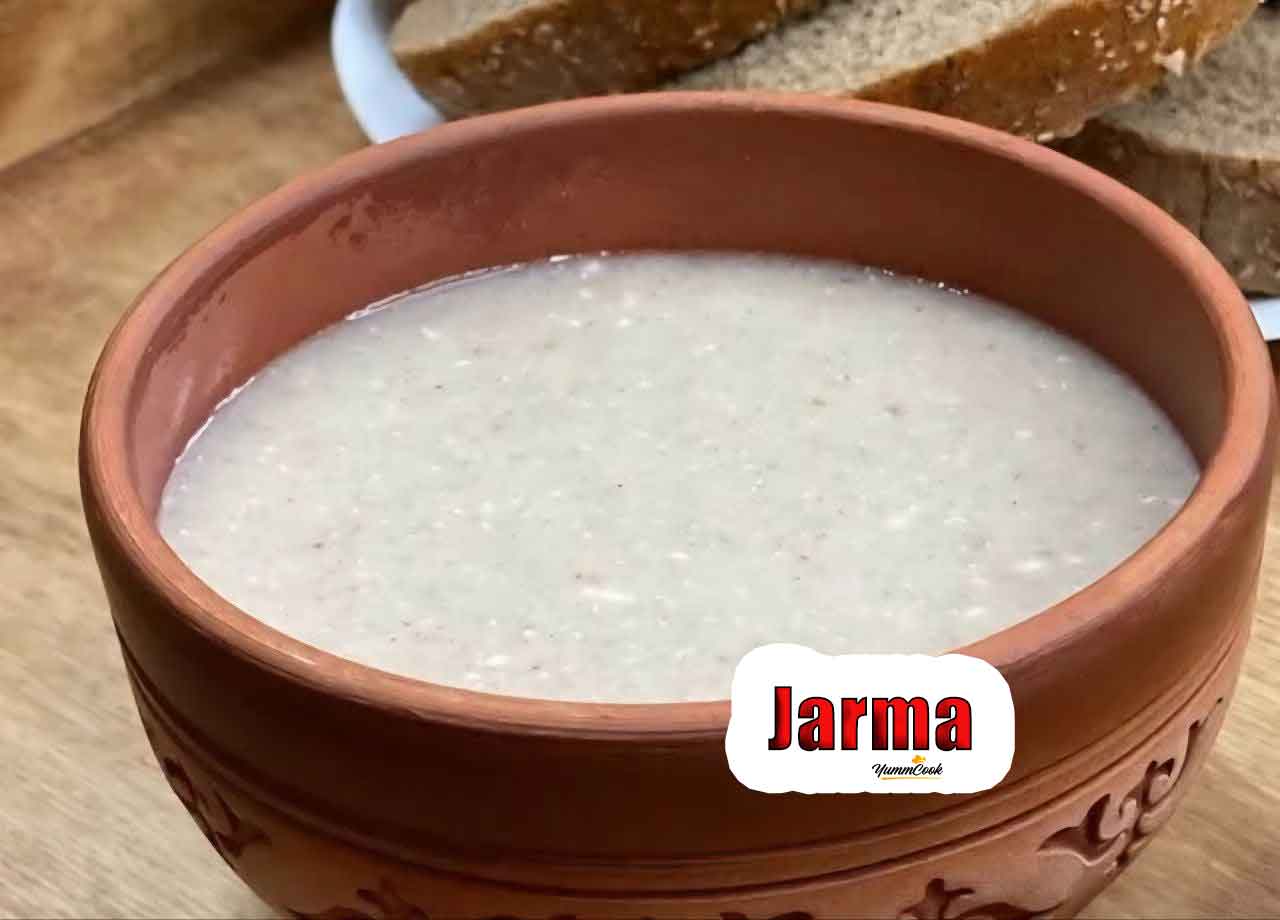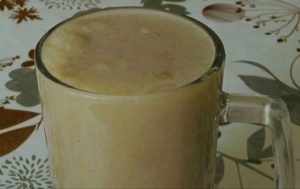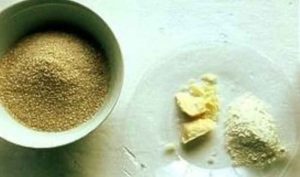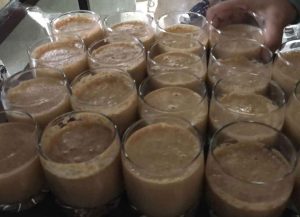Jarma: Traditional Beverage of Kyrgyzstan

Jarma is a healthy and refreshing drink with deep roots in Central Asian culture, mostly consumed in Kyrgyzstan and neighboring countries. This beverage is made from barley or similar grains and has a unique and distinctive taste. Like kefir or kombucha, Jarma is also a fermented drink, rich in probiotics and natural nutrients. For many Kyrgyz families, Jarma is not just a drink, but a symbol of tradition, hospitality, and daily life.

What is Jarma?
Jarma originates from the nomadic lifestyle of the Kyrgyz people, who always relied on simple, nutritious, and accessible foods and beverages. Grains such as barley, wheat, or millet were the main staples of their diet, and this gave birth to a drink like Jarma.
This beverage was mostly consumed in summer and hot weather because it was both cooling and energizing. For centuries, it has been offered in traditional markets and roadside stalls in Kyrgyzstan. Today, some companies produce it industrially, but many families still prepare it at home following traditional recipes. Kuurdak is one of the most famous Kyrgyz dishes that is consumed with this drink.
Ingredients for Homemade Jarma
| Barley flour (or crushed barley) | 1 Cup |
| Water | 4 Cups |
| Plain yogurt or sour cream | 2 Tablespoons |
| Salt | ½ Teaspoon |
How to Make Jarma at Home
Step 1: Initial Preparation
Wash all utensils and equipment with hot water and soap, then dry them thoroughly. Measure all the ingredients in advance to avoid mistakes in proportions.
Step 2: Boiling the Grain Base
Bring the water to a boil in a pot. Gradually add the barley flour or crushed barley while stirring continuously to prevent lumps. Lower the heat and simmer the mixture for 10-15 minutes, stirring occasionally, until it thickens to the consistency of a light porridge or thin soup. If necessary, add a little more water to adjust the texture.
Step 3: Adding Salt and Adjusting Consistency
At the end of cooking, add ½ teaspoon of salt and stir well until it dissolves completely. Check the consistency; if it is too thick, add a small amount of warm water so that it will mix better with the starter once cooled.
Step 4: Cooling Down
Remove the pot from the heat and allow the mixture to cool to room temperature. It is important to cool it completely before adding the starter, because if the mixture is still hot, it can kill the beneficial bacteria and cause the fermentation to fail.
Step 5: Adding the Starter and Mixing
Add 2 tablespoons of plain yogurt or sour cream to the cooled mixture and stir thoroughly until smooth. For a finer texture, you may use a hand blender for 30-60 seconds.
Step 6: Covering and Primary Fermentation
Cover the container loosely with a lid or a clean cloth and leave it at room temperature to ferment. The fermentation time usually ranges between 6 and 12 hours, depending on room temperature and the level of sourness you prefer. Higher temperatures lead to faster fermentation and a stronger flavor.
Step 7: Checking the Flavor and Stopping Fermentation
After at least 6 hours, taste the drink. If it has reached a balanced, mildly sour flavor, stop the process by placing the container in the refrigerator. Otherwise, let it ferment longer until the desired taste is achieved. Refrigeration slows fermentation and stabilizes the flavor.
Step 8: Straining and Preparing to Serve (Optional)
For a smoother texture, strain the Jarma through a fine sieve to remove coarse particles. Place the strained drink in the refrigerator to chill completely; serving it cold enhances its taste and freshness.
Step 9: Serving and Variations
Serve Jarma in a glass or jug. For light flavor variations, you may add fresh mint leaves, a few drops of lemon juice, or a teaspoon of honey. For a dairy-free version, substitute with plant-based yogurt or probiotic starter; note that fermentation time and intensity may differ in this case.
Step 10: Storage and Safety Guidelines
Homemade Jarma is best consumed within 1-2 days when stored in the refrigerator. Discard the drink if you notice a very unpleasant odor, mold, or unusual taste. If liquid separation occurs, stir before serving.

Nutritional Value of Jarma
Thanks to its natural ingredients, Jarma is a nutritious beverage:
- High in fiber from barley, aiding digestion.
- Probiotics from fermentation that support gut health.
- Rich in vitamins and minerals such as calcium, magnesium, phosphorus, and B vitamins.
- Provides complex carbohydrates for sustained energy.
- Low in fat compared to heavy dairy drinks.

Traditional Kyrgyz Jarma (Fermented Barley Drink)
Ingredients
Method
- Wash and dry all utensils and measure ingredients.
- Boil 4 cups of water in a medium pot.
- Gradually add barley flour while stirring to avoid lumps.
- Lower the heat and simmer for 10–15 minutes, stirring occasionally, until it reaches a thin porridge consistency.
- Add ½ teaspoon salt and mix well.
- Remove from heat and let the mixture cool to room temperature.
- Stir in 2 tablespoons of yogurt or sour cream until smooth.
- Cover the container loosely and let it ferment at room temperature for 6–12 hours.
- Taste the drink; once mildly sour, refrigerate to stop fermentation.
- Strain for a smoother texture, chill, and serve cold.
Benefits of Jarma
Like many fermented foods and drinks, Jarma offers several health benefits:
- Improves digestion due to probiotics.
- Provides better hydration than sugary industrial drinks.
- Acts as a natural energy booster thanks to complex carbohydrates.
- Supports immune function through a healthy gut.
- Low in calories and filling, making it suitable for weight management.
Disadvantages and Limitations of Jarma
Of course, like any other drink, Jarma has some limitations:
- Its fermented and sour taste may not appeal to everyone.
- Lactose intolerance: people sensitive to lactose should prepare the dairy-free version.
- Short shelf life: homemade Jarma lasts only 1-2 days.
- Digestive sensitivity: People not used to probiotics may experience mild stomach discomfort at first.
History of Jarma in Kyrgyzstan
In Kyrgyz culture, Jarma is more than just a beverage. It is traditionally offered to guests at ceremonies, celebrations, and family gatherings. In summer, street vendors serve it in large containers in markets and on roadsides.

Conclusion
Jarma is a traditional and healthy Kyrgyz beverage that brings together nature, wellness, and culture. With its nutritional value, probiotics, and simple homemade preparation, it is an excellent alternative to sodas and commercial energy drinks. Introducing this beverage to American audiences can build a bridge between Central Asian traditions and modern lifestyles. Jarma might soon become the next popular drink to stand alongside kombucha and kefir in the world of healthy nutrition.
1. What is Jarma?
Jarma is a traditional Kyrgyz fermented barley drink, refreshing and rich in probiotics.
2. How long does homemade Jarma last?
It’s best consumed within 1-2 days when stored in the refrigerator.
3. Does Jarma contain alcohol?
No, Jarma is a non-alcoholic fermented drink.
4. Can lactose-intolerant people drink Jarma?
Yes, by using dairy-free yogurt or plant-based probiotic starters.
5. What does Jarma taste like?
It has a light, slightly sour, and refreshing flavor, similar to kefir or kombucha.
